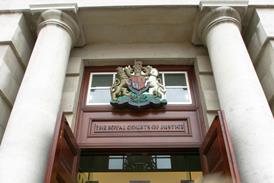A landowner who sold two 18th century lead urns he had inherited with his home without realising that they were subject to a listing order has had his appeal against an enforcement notice backed by the Supreme Court. Today's ruling in Dill v Secretary of State for Housing and Local Government could help clarify the definition of 'building' on the statutory list.
The urns in question and their limestone pedestals were sold by auction in 2009 by Marcus Dill, who had inherited them from his father as part of the estate at Idlicote House, Shipston-on-Stour. Six years later, after the urns had left the country, Stratfod-on-Avon district council informed Dill that he should have obtained listed building consent for the items to be removed. The Supreme Court was ruling on an appeal by Dill against a decision of the Court of Appeal that he could not appeal on the ground that the urns were not 'buildings' and therefore should not have been listed.
Ordering the enforcement appeal to be remitted for redetermination, Lord Carnwath found that nothing in statute prevents someone accused under the Listed Buildings Act arguing that the item demolished is not a 'building' and so not within the definition.
Simon Stanion, planning partner at national firm Shakespeare Martineau, who acted for Dill, described the decision as 'a complete vindication of the position taken by Mr. Dill from the very outset'.
'This is an important decision not only in terms of the matters that may be raised by way of listed building enforcement appeal, but also in terms of the guidance handed down by the court regarding assessing whether individually listed items, such as the urns in this case are in fact "buildings",' Stanion said.
Dill said: 'I was sure of the facts of this matter: the urns had passed down three generations and had moved with the family from place to place in the 1950s, 1960s and 1970s. They had no relation to the listed houses where they had been situated, least of all Idlicote House where they ended up, and nothing in the listing description recognized their true provenance. I had acted in good faith when I sold the urns and I had no reason to believe they were listed or that they were "buildings" in law.'
In judgment, agreed by Lord Wilson, Lady Arnold, Lord Kitchin and Lord Sales, Lord Carnwath noted 'a disturbing lack of clarity' about the criteria adopted by local authorities in determining whether free-standing items qualify for listing protection.
Richard Harwood QC and Catherine Dobson, instructed by Shakespeare Martineau LLP, appeared for Dill; David Elvin QC and Guy Williams, instructed by the Government Legal Department, for the secretary of state and John Hunter, instructed in-house, for Stratford-on-Avon District Council.


























9 Readers' comments